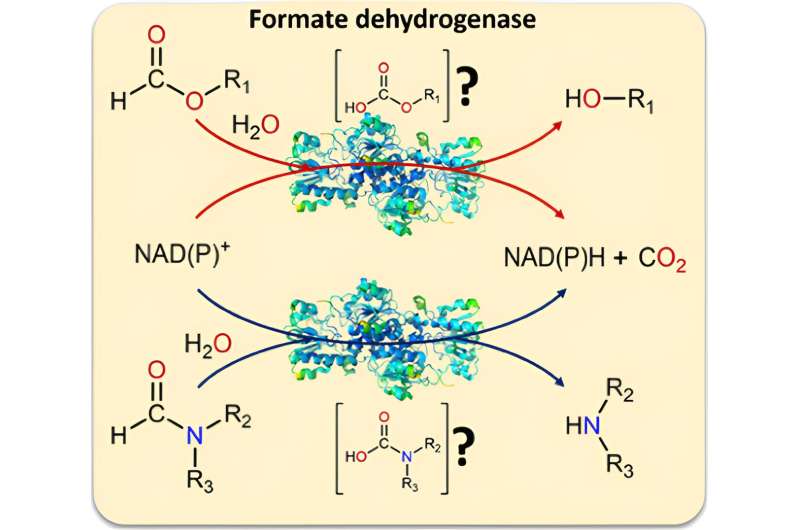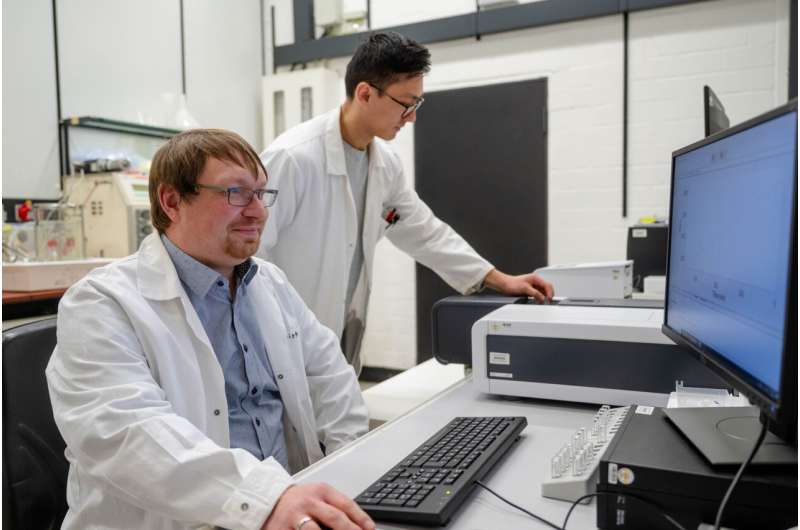This article has been reviewed according to Science X's editorial process and policies. Editors have highlighted the following attributes while ensuring the content's credibility:
fact-checked
peer-reviewed publication
trusted source
proofread
Enzyme for biocatalysis uses solvent as a substrate

A large number of applications in the chemical industry rely on the molecules NADH or NADPH as fuel. A team led by Professor Dirk Tischler, head of the Microbial Biotechnology working group at Ruhr University Bochum, used a biocatalyst to study their production in detail.
The researchers proved that, in addition to formate, the biocatalyst formate dehydrogenase can also convert formamides. This means, for one thing, that the enzyme can also cleave the difficult-to-break C–N bond. For another, formamides are a common solvent.
"This opens up completely new possibilities for poorly soluble NADH reactions as well as NADPH-dependent reactions," says Tischler.
The researchers published their findings in the journal ACS Catalysis on January, 26, 2024.
Formate dehydrogenase is used in biocatalytic processes to make electrons available as fuel for further reactions by removing them from a substrate. In current applications, the substrate is NAD+ and the product is NADH. The waste product is CO2.
"This is a good thing in this case, as it escapes as a gas and therefore prevents the desired reaction from taking place in reverse," explains Tischler.
As the NADPH variant—with one more phosphate group—is often required as a product, his team created mutants of the biocatalyst that converts NADP+ into the desired product.

What if the catalyst also breaks the C–N bond?
While working on the formate dehydrogenase, the researchers realized that little was known about alternative starting materials for the biocatalyst. "We looked at various possible substrates (formate derivatives) and found that a C–O bond is always broken when they are converted by the biocatalyst," explains Tischler. "This gave us an idea: What if the enzyme could also cleave C–N bonds—traditionally a difficult task to solve?"
Further tests showed that the biocatalyst is indeed capable of this: It can also convert formamides, derivatives of the formate with an additional compound to form a nitrogen, as a starting material. Since formamides are common and inexpensive solvents, they serve as both solvent and substrate in this reaction. It's also possible to provide NADH and NADPH in this constellation. CO2 is produced as a waste product in these reactions, too, and, by escaping, prevents the reactions from running backwards.
"This reaction has never been described before," says Tischler. His team showed that using formamides as an electron source for NADPH formation can achieve equivalent or even slightly better results compared to the conventional system with formate.
"This opens up completely new possibilities, as our more stable mutants are still active in up to 40% by volume of formamides," says the researcher.
More information: Artur Maier et al, Unlocking Catalytic Diversity of a Formate Dehydrogenase: Formamide Activity for NADPH Regeneration and Amine Supply for Asymmetric Reductive Amination, ACS Catalysis (2024). DOI: 10.1021/acscatal.3c05409
Journal information: ACS Catalysis
Provided by Ruhr-Universitaet-Bochum





















